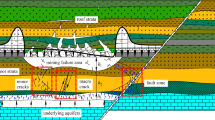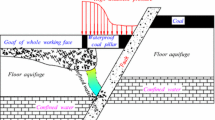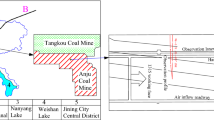Abstract
In underground coal mining, the presence of high-permeability geological faults may cause a large amount of groundwater to suddenly erupt from the aquifer, resulting in undesirable casualties and economic losses. In order to deeply understand the mechanism of underground water inrush caused by typical faults in eastern China, the Zhuxianzhuang Coal Mine was selected as an engineering project case study. The study was analyzed by means of similar-physical experiments and numerical analysis. Research shows the following: (1) Similar-physical experiment results indicate that the evolution process of fault seepage can be divided into five stages: seepage initiation, seepage development, seepage mutation, seepage burst and seepage stability. Seepage types can be summarized as initial pore flow, middle fracture flow, and late channel flow. It is clear that the water pressure, the thickness of aquifuge and the material gradation have an important influence on the seepage characteristics of fault. The migration and loss of particle fillings in fault are the main factors of seepage changes. Under the sustained action of water pressure, the permeability of fault continuously increases, and eventually the fracture flow converts into the channel flow, resulting in the formation of water inrush channels in fault. (2) Numerical simulation results indicate that the failure zone in the floor strata can be divided into mining-induced damage zone, effective water-resisting zone, and fault activation zone, the effective water-resisting zone is the key part of preventing water inrush. Cracks propagation, stress distribution and seepage evolution in the floor strata can be visualized during the formation of the water inrush pathway. Once mining-induced cracks intersect with cracks caused by fault activation, the seepage increases rapidly, and groundwater will flow into the mining face, resulting in water inrush. (3) When mining coal mines with high-permeability faults, the seepage in faults should be regularly monitored, and sufficient attention should be paid to the seepage mutation, which is crucial for accurately assessing the risk of water inrush from fault.

















Similar content being viewed by others
Data Availability
Enquiries about data availability should be directed to the authors.
References
Babiker M, Gudmundsson A (2004) The effects of dykes and faults on groundwater flow in an arid land: the Red Sea Hills. Sudan J Hydrol 297(1):256–273
Bieniawski ZT (1973) Engineering classification of jointed rock masses. Civ Eng S Afr 15:335–343
Bieniawski ZT (1987) Determining rock mass deformability: experience from case histories. Int J Rock Mech Min Sci Geomech Abstr 15(5):237–247
Cao YX, He DD, Glick DC (2001) Coal and gas outbursts in footwalls of reverse faults. Int J Coal Geol 48(1):47–63
Chen JH, Li DQ (2022) Numerical simulation of fully encapsulated rock bolts with a tri-linear constitutive relation. Tunnelling and Underground Space Technology 120: 104265
Chen JH, Liu P, Zhao HB, Zhang C, Zhang JW (2021a) Analytical studying the axial performance of fully encapsulated rock bolts. Engineering Failure Analysis 128: 105580.
Chen JH, Zhao HB, He FL, Zhang JW, Tao KM (2021b) Studying the performance of fully encapsulated rock bolts with modified structural elements. International Journal of Coal Science & Technology 8:64–76
Fang Z, Harrison JP (2002) Development of a local degradation approach to the modeling of brittle fracture in heterogeneous rocks. Int J Rock Mech Min Sc 39(4):443–457
Islam MR, Shinjo R (2009) Mining-induced fault reactivation associated with the main conveyor belt roadway and safety of the Barapukuria Coal Mine in Bangladesh: Constraints from BEM simulations. Int J Coal Geol 79(4):115–130
Jia MK (2012) The Study on the Deformation Process of Overlying Strata in the Deep and Thin Bedrock. J Min Safety Eng 29(2):168–172 ((Chinese))
Karacan CÖ, Ulery JP, Goodman GVR (2008) A numerical evaluation on the effects of impermeable faults on degasification efficiency and methane emissions during underground coal mining. Int J Coal Geol 75(4):195–203
Kong XY (2010) Advanced Mechanics of Fluids in Porous Media, 2nd edn. USTC Press, Hefei China
Li H, Bai HB, Wu JJ, Wang CS, Ma ZG, Du YB, Ma K (2017) Mechanism of water inrush driven by grouting and control measures—a case study of chensilou mine, china. Ara J Geosci 10(21):468
Li LC, Tang CA, Zhao XD, Cai M (2014) Block caving-induced strata movement and associated surface subsidence: a numerical study based on a demonstration model. B Eng Geol Environ 73(4):1165–1182
Li LC, Tang CA, Liang ZZ (2010) Investigation on overburden strata collapse around coal face considering effect of broken expansion of rock. Rock Soil Mech 31(11):3537–3541
Li LC, Yang TH, Liang ZZ, Zhu WC, Tang CA (2011) Numerical investigation of groundwater outbursts near faults in underground coal mines. Int J Coal Geol 85(3–4):276–288
Liu SL, Liu WT, Shen JJ (2017) Stress evolution law and failure characteristics of mining floor rock mass above confined water. KSCE J Civ Eng 21(7):2665–2672
Liu Z, **ong C (2007) Numerical simulation study on water inrush mechanism from collapse column. Chin J Rock Mech Eng 26:4013–4018 ((Chinese))
Lu Q, Li X, Li W, Liu SL (2018) Risk evaluation of bed-separation water inrush: A case study in the Yangliu coal mine. China Mine Water Environ 37(2):288–299
Lu YL, Wang LG (2015) Numerical simulation of mining-induced fracture evolution and water flow in coal seam floor above a confined aquifer. Comput Geotech 67:157–171
Ma D, Bai HB, Wang YM (2015) Mechanical behavior of a coal seam penetrated by a karst collapse pillar: mining-induced groundwater inrush risk. Nat Hazards 75(3):2137–2151
Ma GW, Wang XJ, Ren F (2011) Numerical simulation of compressive failure of heterogeneous rock-like materials using SPH method. Int J Rock Mech Min Sci 48(3):353–363
Minkoff SE, Stone CM, Bryant S, Peszynska M, Wheeler MF (2003) Coupled fluid flow and geomechanical deformation modeling. J Petrol Sci Eng 38(1–2):37–56
Mohamma N, Reddish DJ, Stace LR (1997) The relation between in situ, and laboratory rock properties used in numerical modelling. Int J Rock Mech Min Sci 34(2):289–297
Nicholson GA, Bieniawski ZT (1990) A nonlinear deformation modulus based on rock mass classification. Int J Min Geo Eng 8(3):181–202
Niu LL, Zhu WC, Cheng Z, Guan K, Qin T (2017) Numerical simulation on excavation-induced damage of rock under quasi-static unloading and dynamic disturbance. Environ Earth Sci 76(17):614
RFPA User Manual (2005) Dalian Mechsoft Co., Ltd. Dalian, China.
Shi WH, Yang TH, Yu QL, Li Y, Liu HL (2017) A Study of Water-Inrush Mechanisms Based on Geo-Mechanical Analysis and an In-situ Groundwater Investigation in the Zhongguan Iron Mine. China Mine Water Environ 36(3):409–417
Souley M, Homand F, Pepa S, Hoxha D (2001) Damage-induced permeability changes in granite: a case example at the URL in Canada. Int J Rock Mech Min Sci 38:297–310
Tang CA (1997) Numerical simulation on progressive failure leading to collapse and associated seismicity. Int J Rock Mech Min Sci 34:249–261
Tang CA, Tham LG, Lee PK (2002) Coupled analysis of flow, stress and damage (FSD) in rock failure. Int J Rock Mech Min Sci 39(4):477–489
Wang LG, Miao XX (2006) Numerical simulation of coal floor fault activation influenced by mining. J Chin Univ Min Technol 16(4):385–388 ((Chinese))
Weibull W (1951) A statistical distribution function of wide applicability. J Appl Mech 13(2):293–297
Wu Q, Wang M, Wu X (2004) Investigations of groundwater bursting into coal mine seam floors from fault zones. Int J Rock Mech Min Sci 41(4):557–571
Yang TH, Liu J, Zhu WC, Elsworthc D, Thamd LG, Tang CA (2007) A coupled flow-stress-damage model for groundwater outbursts from an underlying aquifer into mining excavations. Int J Rock Mech Min Sci 44(1):87–97
Yang TH, Tham LG, Tang CA, Liang ZZ, Tsui Y (2004) Influence of heterogeneity of mechanical properties on hydraulic fracturing in permeable rocks. Rock Mech Rock Eng 37(4):251–275
Yao BH, Bai HB, Zhang BY (2012) Numerical simulation on the risk of roof water inrush in Wuyang coal mine. Int J Min Sci Technol 22(2):237–277
Yin SX, Zhang JC, Liu DM (2015) A study of mine water inrushes by measurements of in situ stress and rock failures. Nat Hazards 79(3):1961–1979
Yuan SC, Harrison JP (2005) Development of a hydro-mechanical local degradation approach and its application to modelling fluid flow during progressive fracturing of heterogeneous rocks. Int J Rock Mech Min Sci 42(7):961–984
Zhang HQ, He YN, Tang CA, Ahmad B, Han LJ (2009) Application of an improved flow-stress-damage model to the criticality assessment of water inrush in a mine: A case study. Rock Mech Rock Eng 42(6):911–930
Zhang JC, Peng SP (2005) Water inrush and environmental impact of shallow seam mining. Eng Geol 48(8):1068–1076
Zhang R, Jiang ZQ, Zhou HY, Yang CW, **ao SJ (2014) Groundwater outbursts from faults above a confined aquifer in the coal mining. Nat Hazards 71(3):1861–1872
Zhao HJ, Ma FS, Xu JM, Guo J (2012) In situ stress field inversion and its application in mining-induced rock mass movement. Int J Rock Mech Min Sci 53:120–128
Zeng YF, Wu Q, Liu SQ, Zhai YL, Lian HL, Zhang W (2017) Evaluation of a coal seam roof water inrush: case study in the Wangjialing coal mine. China Mine Water Environ 37(3):1–11
Zhu WC, Wei CH (2011) Numerical simulation on mining-induced water inrushes related to geologic structures using a damage-based hydromechanical model. Environ Earth Sci 62(1):43–54
Zuo JP, Peng SP, Li YJ, Chen ZH, **e HP (2009) Investigation of karst collapse based on 3-D seismic technique and DDA method at **eqiao coal mine. China Int J Coal Geol 78(4):276–287
Acknowledgements
The study is jointly supported by grants from the Key Program of National Natural Science Foundation of China (Grant No. 51534003); National Key Research and Development Program of China (Grant No. 2016YFC0801601; 2016YFC0801606; 2016YFC0801604). The authors are grateful for these supports.
Funding
the key program of national natural science foundation of china,51534003,Jianli Cao,national key research and development program of china,2016YFC0801606,Jianli Cao
Author information
Authors and Affiliations
Corresponding author
Ethics declarations
Competing Interests
The authors have not disclosed any competing interests.
Additional information
Publisher's Note
Springer Nature remains neutral with regard to jurisdictional claims in published maps and institutional affiliations.
At the same time, the use of grouting and rock reinforcement methods can improve the integrity of the coal mine rock mass and play an important role in preventing water inrush hazards.
Rights and permissions
About this article
Cite this article
Zhang, D., Wang, J., Guo, S. et al. Research on the Underground Water Inrush Mechanism Based on the Influence of Fault. Geotech Geol Eng 40, 3531–3550 (2022). https://doi.org/10.1007/s10706-022-02113-w
Received:
Accepted:
Published:
Issue Date:
DOI: https://doi.org/10.1007/s10706-022-02113-w




